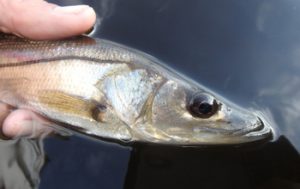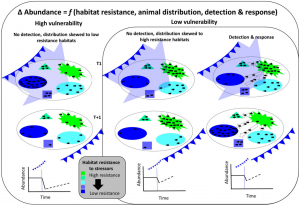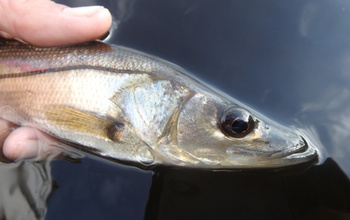Snook in Extreme Environments
By Delaney Reynolds, SRC Intern
Earth’s climate is warming, and rising temperatures are impacting animal species and their habitats in alarming ways. Since 1970, temperatures have increased approximately 0.17°C (0.3°F) per decade (Dahlman, 2017). Such changes threaten animals’ ability to adapt to increased heat and induced stress. In the article, “Can animal habitat use patterns influence their vulnerability to extreme climate events? An estuarine sportfish case study,” researchers observed how migration patterns impacted species’ vulnerability to extreme climate events (ECEs), episodes of uncommon climactic periods in which ecosystem structure is transformed beyond what is characteristically normal (Smith, 2011).

A Juvenile Common Snook caught in the Everglades National Park. Image Source: https://www.nsf.gov/news/mmg/mmg_disp.jsp?med_id=132218&from=mn
The State of Florida enjoys mild lows of 65-41°F during its winter season. Extreme cold fronts, however, occur approximately once every 10 years and can result in colder, more fatal environmental systems. During extreme cold fronts, South Florida’s Everglades National Park often experiences dramatic declines in sportfish populations and, thus, is the experimental ground used to study Snook and climate vulnerability. In 2010, for example, the Park faced one of its most severe cold fronts in a century and saw imperative tropical fisheries decrease 80%.
One of the Park’s residents, the Common Snook, has been useful in studying climate vulnerability because, “the abundance of adult Snook, the most sought after gamefish in the area, decreased by over 90% following the passage of this event” (Boucek, 2017). Once water temperature drops below 60°F, the Snook begin to struggle and become particularly vulnerable.
Looking at Everglades estuaries, Common Snook are observed in various cold-temperature regions. Snook often reside in rivers and for this reason three distinctive areas of the Everglades’ Shark River estuary were studied: the upstream, bay, and downstream zones. The downstream zone consists of the most Snook predators, but also the most Snook prey, and so Snook population and productivity is relatively higher compared to the upstream and bay zones. Passive acoustic telemetry computed Snook distribution patterns predicted for 2012 to 2016 during ECE periods. The researchers found that downstream zones were found to be the warmest, causing little effect on Snook populations, and upstream zones the coldest, killing most tropical fish. When a cold spell is detected in high vulnerability communities, most fish species migrate to areas of higher resistance, ensuring a higher survival rate. When it came to dispersing among less vulnerable habitats, Snook did not portray migration tendencies when detecting ECEs. Another study during the 2010 ECE found that most Everglades Snook showed the same behavior and did not move long distances, but rather made short journeys to areas that would function as a refuge from less severe, but more frequent ECEs (Stevens, 2016).

This figure demonstrates animal distribution in high and low resistance environments, the shaded shapes, as well as their response to ECEs. As shown on the right, when a cold spell is detected in low vulnerability communities, fish will migrate to areas of higher resistance (shown in bright green) and return to their original habitat once it has passed, ensuring a higher rate of survival among the population. Image Source: Can animal habitat use patterns influence their vulnerability to extreme climate events? An estuarine sportfish case study.
Snook face higher risk of population degradation when they are unable to immigrate to congenial territories, yet their populations did not face large casualties due to the ECEs because they tend to typically dwell in the warmer downstream zone. By staying in warm water areas, the Common Snook helps us better understand how species respond to a change in their habitats’ climate. As ECEs become more common and severe it will be vital to continue to monitor fisheries so as to learn how our warming climate impacts species and their habitats.
Works Cited
Boucek, R. E., Heithaus, M. R., Santos, R., Stevens, P., & Rehage, J. S. (2017, April 7). Can animal habitat use patterns influence their vulnerability to extreme climate events? An estuarine sportfish case study. Retrieved from file:///C:/Users/derey/Downloads/boucek%20et%20al%202017b.pdf
Dahlman, L. (2017, September 11). Climate Change: Global Temperature. Retrieved October 22, 2017, from https://www.climate.gov/news-features/understanding-climate/climate-change-global-temperature
Smith, M. D. (2011, April 15). An ecological perspective on extreme climatic events: a synthetic definition and framework to guide future research. Retrieved from http://onlinelibrary.wiley.com/doi/10.1111/j.1365-2745.2011.01798.x/abstract




Leave a Reply
Want to join the discussion?Feel free to contribute!